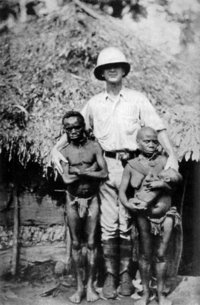
In Ousmane Sembene’s 1975 film Xala, his dedication to cinema engage is very clear. He does not hide the fact that this is a film about the corruption and failure of Senegalese independence from the French. Through somewhat stilted acting and almost laughable action in some scenes, the story focuses on one corrupt Senegalese man, El Hadji Abdou Kader, who is part of the new cabinet and symbolizes the extent of unspoken crimes against the people. Kadar has received the Xala, a curse that causes impotence, and its symbolism to the impotence of this new African regime is obvious. The film begins with a tilt shot of the steps of the government building as we see eight traditionally clad Senegalese men strut up to the top and wave to their people in triumph. This angled tilt shot emphasizes their victory over the French. They enter the chamber office where they proceed to take items representing the French colonization such as busts of French leaders, boots and hats and place them at the top of the stairs. The next shot cuts to the chamber room again where the President of the new regime points to the three French businessmen to leave and the scene cuts to a tilt shot of the steps again as the French ousted leaders pick up these items and walk down and off the frame, denoting the defeat of French colonialization and the take-over of a new African cabinet.
In the following scene, we see a tilt shot downward as a red carpet rolls down the steps to announce the new African regime. They walked up the steps connoting hope of a new and better government, but Sembene diffuses any hope of change. As the new African leaders are shown now clad in business suits walking down the steps each with a briefcase filled with money, they are helped one after another into a waiting line of Mercedes, capitalistic icons. Sembene has many sequences throughout the film that show objects and people in lines. The powerful viewpoint in this scene from the front of this line of Mercedes underlines the rampant corruption that has been internalized by these colonized Africans as we see that they all are no different than the colonizers enjoying the capitalistic perks of being in power.
Kadar has used money he has taken meant to buy supplies for the people to buy a third virgin wife, and even though he is not alone in his corruption techniques and self-reward, this begins his downfall. The wedding party is about to begin and again Sembene uses sequence shots to show the guests arriving, the wedding party of the bride arriving in cars and the Mercedes arriving in sequence just as they left the government building. Through this technique, African society is seen as lemmings where tradition and colonial ideas are followed without challenge or change. Another tilted shot occurs at the end of the wedding party reminiscent of the earlier shot of the traditionally clad new African leaders walking up the steps after forcefully taking over the government. In this scene, the viewpoint is from the back of Kadar, his new bride and her mother leading them silently up the steps to the bedroom where Kadar is about to forcefully take over his virgin wife. This power that Kadar believes he has is a false and pathetic power and we see Kadar’s impotency ooze into all areas of his life when he is ousted from power, loses his two younger wives and is confronted by the beggars seen throughout the film.
In the final scene of the film, the beggars invade his home and one of them reveals that he is responsible for the xala because Kadar had extorted funds and ruined his family. Earlier in the film Sembene introduces us to this group with some sequence shots of them walking and hobbling with sticks or on disfigured legs, which displays their horrible personal conditions. These sequence shots of the beggars places them as a shocking binary to the sequence shots of the Mercedes. These homeless people are portrayed as more generous and self sufficient than the government leaders. In the end, Kadar’s xala is removed by the action of each one of them spitting on Kadar’s naked body. Perhaps Sembene offers another way for the future of Africa than post-colonial corruption when he has a medicine man say to Kadar, “What one hand removes, another can put back.”





No comments:
Post a Comment